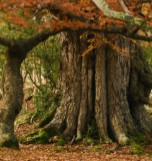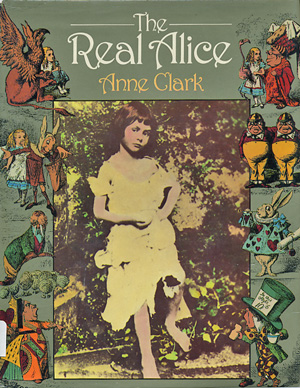| Date | Title |
| April 2010 | Records of Burley |
| Mar 2010 | Lascelles' 35 Years in the New Forest |
| Feb 2010 | Kelly's County Directories |
| Jan 2010 | Ernest Haslehust's The New Forest |
| Nov/Dec 2009 | New Forest Documents |
| Sep/Oct 2009 | The Commoners' New Forest |
| August 2009 | The New Forest by Colin Tubbs |
| July 2009 | Comyn's New Forest |
| June 2009 | Anne Clark's The Real Alice |
| May 2009 | The New Forest Register of Decisions on Claims to Forest Rights |
| April 2009 | Sumner's Guide to the New Forest |
| March 2009 | John Wise's The New Forest Its History and Scenery |
Records of Burley
compiled by Felicity Hardcastle B.E.M. appeared in two guises. The original published in 1951 whilst the larger, more comprehensive version, appeared in 1987. Miss Hardcastle readily admits that even the latter work is incomplete ‘I have not dared to call this book the History of Burley… I am fully aware that very much yet remains to be discovered…’ Despite these remarks in the preface she has produced a work that has become a classic village history. The subtitle – Aspects of a New Forest Village shows her awareness of its limitations yet it provides a marvellous vision of her village in its setting.
The book commences with a series of aerial photograph showing both detail and the setting of the village before reciting some of the stories of poachers and smugglers which give character to the place. Then the work continues on a more conventional basis with the Early History and its links with the Forest through The Bailiwick of Burley, one of the ancient divisions that made up the New Forest . Burley Manor follows and then for the remainder of the book she concentrates on Burley Vill and the various aspects that made up the village.
As is so often the case with such work Miss Hardcastle was not Burley born and Burley bred but an incomer. Her mother came to Burley in 1919, following the death of her husband, when Felicity was in her teens. Although qualified to gain entrance to a university she stayed at home with her mother as was the custom of the day with so many. Gradually the young Miss Hardcastle came to seek a life for herself, first in the Forest , able to assist a local poacher and skin and dress a rabbit and then taking part in village affairs. Her work in various organisations together with her curiosity and interest in natural history gave her a terrific knowledge of the workings of the village.
Seventy pages of the book are devoted to place names covering places shown on the earliest Manor Map as well as individual properties. The first known mention, any related documents, together with occupiers and owners as well as a precise location is listed. There are also chapters on natural and social history as well as details of some families. Well illustrated with numerous list it is an extraordinarily rich source for topographical and family historians and rewards examination in detail. The book was published just a few months before her death in January 1988.
Gerald Lascelles's
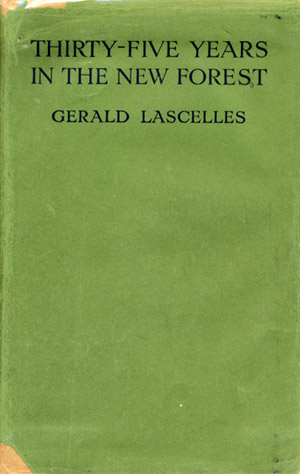 35 years in the
35 years in the
He was the second Deputy Surveyor to live at Queen’s House in
A keen sportsman and author, he wrote the articles on Sport in the New Forest and, with J Nisbet , Forestry and the New Forest in the Hampshire section of the Victoria County History as well as a number of other, mostly sporting works, notably The Art of Falconry of which he was a master.
He was perhaps the last of what may be termed the truly amateur land managers of the
He succeeded Lawrence Cumberbatch who had been forced to leave the job suffering from a nervous condition, something that was to impair Lascelles’s health towards the end of his term in office. He found it hard to accept the new role of the verderers and a number of the comments in the book may be seen as ‘getting his own back’ for the difficulties he had had to work under. That apart it provides a unique insight into the working of the
However he set to, reading the various official reports back to the fifth report of 1789: ‘No one… should fail to study this most excellent and comprehensive report.’ Although his book has sections on his various interests and the conflicts within the
Kelly's County Directories
 produced, from the middle of the 19th century until 1939 at four to five years intervals, are an invaluable source of economic and social history. Each and every village in the county is listed with a brief introduction to its history, current land ownership and important community services such as schools and post offices. Inhabitants are listed under headings of private individuals and commercial. Only the more prominent residents are shown along with a good range of trading activity. Whilst neither list is complete it does help to bring to life the make-up of a community at a particular time.
produced, from the middle of the 19th century until 1939 at four to five years intervals, are an invaluable source of economic and social history. Each and every village in the county is listed with a brief introduction to its history, current land ownership and important community services such as schools and post offices. Inhabitants are listed under headings of private individuals and commercial. Only the more prominent residents are shown along with a good range of trading activity. Whilst neither list is complete it does help to bring to life the make-up of a community at a particular time.
Lists covering the poor law unions, magistrates and other county information are also included with further administrative details. A ‘court directory’ listing the private residents alphabetically as well as a comprehensive trade directory assures ease of use. One can soon establish if an individual is still trading or has moved to another place in the county. The headings of course change over time giving an insight into different industries: Bark Merchants and Charcoal Burner for example still appear in 1895 but have gone by the end of the series in 1939.
As a series of snapshots showing change over time the directories become even more valuable showing the progress of individuals, businesses and the community as a whole. Used in conjunction with sources such as the census returns an idea of the health of a particular village starts to emerge.
It is not just villages that appear for townships such as Broomy have a small section in which one learns from the 1875 edition that ‘Broomy township was constituted by an order of the Poor Law Board, dated 23rd November 1868; and by a subsequent order dated 12th February 1869 was added to the Ringwood Union: it is comprised of places that were extra-parochial’. It virtually details each and every cottage that makes it up along with five of the inhabitants.
The name Kelly is the best known of the directory publishers; one of the family, Festus Kelly lived at Northerwood in
In addition to these county directories there were a number of town ones, some of which covered the local country areas.
E.W. Haslehust, R.B.A. was the artist
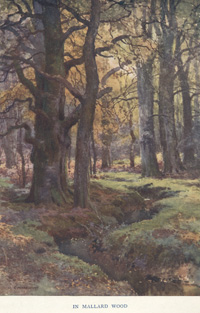 behind many of the books in the Beautiful England series, each contained twelve reproductions of his watercolours. The New Forest, undated but first issued in 1912 by Blackie & Son of Glasgow, is a slim volume of 64 pages with the requisite dozen illustrations as well as text on the state of the countryside at the end of the Edwardian era. 'In these modern days, when towns are increasing on every side, and the new idea of garden cities threatens to swallow up what little is left us of the true country, it is good to remember that in one quiet corner of Hampshire lies a sanctuary...'
behind many of the books in the Beautiful England series, each contained twelve reproductions of his watercolours. The New Forest, undated but first issued in 1912 by Blackie & Son of Glasgow, is a slim volume of 64 pages with the requisite dozen illustrations as well as text on the state of the countryside at the end of the Edwardian era. 'In these modern days, when towns are increasing on every side, and the new idea of garden cities threatens to swallow up what little is left us of the true country, it is good to remember that in one quiet corner of Hampshire lies a sanctuary...'
The first chapter draws heavily on the work of John Wise fifty years earlier in outlining the origins of the Forest. Then, as many writers have before and since, the author takes a tour around the Forest starting with 'Brockenhurst and the Moorland' heading on to 'Beaulieu, betwixt the wood and the sea', Lyndhurst, the greenwood', 'The highroads and the playgrounds' before heading upwards to 'Bramshaw, the hill country' and rounding off with 'Burley, the western border'.
Whilst mention is made of the villages, usually in connection with an historical tale it is the woods and heaths that attract most attention. Sometimes the poetry in the writing carries the author away: 'Coming down the broken upland through Broomy by winding ways and chalky ledges, at dusk one may see a little troop of deer stooping their branchy heads to drink at the brook by Holly Hatch,...' If there is one thing we are sure of it is that there is no chalk in the Forest. However the style is entertaining and offers an appreciation of the countryside together with some charming watercolours from a century ago.
The writing is descriptive and conjures up the period very well: 'Now through July and August the lawns are dotted with childish cricketers, and crowds of little folk trot about with mugs slung round their necks. The strong oak branches lend themselves to swings, and the thickets farther down suggest “I spy!”.' This is the area leading from what was Lyndhurst Road Station which remains a popular area for visitors with the proximity of the pub and camp site.
Haslehust contributed to more than thirty books in the Beautiful England and although not a great artist his work evokes a time and place very well, often reinforcing childhood memories. He collaborated with fellow artist and author Sidney Heath in many publications. He was born in 1866 and died in 1949.
New Forest Documents
This book was the first of two similar titles edited by the late David Stagg. Published in 1979 it is the third volume in the Hampshire Record Series produced by Hampshire Country Council. As stated by its title it consists of translations of New Forest documents from the medieval period, in particular those originating from the Forest Courts, mainly those of the Forest Justices but lesser courts also. The documents are placed in context by a full and reliable introduction which, although technical, is a standard work for those considering this period of Forest history. The introduction includes a very full section on Forest Law in general together with a piece concerning the application of common law within the New Forest as the 1257 Forest Eyre considered by Forest and Civil Pleas; it is often stated, incorrectly, that Common Law was not applied within Forests. The Forest Eyre itself is described as might be expected from a book which contains so much derived from that source. The lower forest courts are also considered in detail as are the forests officers. In addition to the Court records are some Accounts, Surveys and Extents which include much interesting information, including that in regard to the operation of Forest Rights at this period and these are both discussed at length in the introduction. Discussion is made regarding the medieval bounds of the Forest which were very much tied up with the politics of the day, though only the ‘large bounds’ are contained within the book itself, the small bounds being published in a number of other locations. What must be borne in mind is that the villages within the Forest area were also considered to form part of the Forest and therefore much material is included on them, the link between the forest wastes and enclosed lands was not lost on the medieval foresters. A useful discussion is also given on material contained in the Pipe Rolls and an index of Forest material from those published by the time David was writing is included as an appendix. While this information may not inspire many people to rush out and find a copy for themselves, those that do will find the main text full of entertaining entries detailing the misdemeanours of Forest people throughout the Forest often in places now lost to modern memory. But for those who wish to come to a full understanding of the Forest at this period this particular book is a must and amazingly it is still in print and available from the Hampshire Record Office, Winchester.
The Commoners’ New Forest
This book was written by Dr F.E. Kenchington, whose family roots were from the Forest and who had returned there whilst working for the County War Agricultural Committee; working on the ‘reclamation’ of Forest lawns and cultivation of the Forest wastes to reduce demands on foreign supplies of food stuffs.
The book was first published by Hutchinson & Co. Ltd. in 1944, with reprints in 1945 and 1949, but apparently finished at the end of 1942 as indicated by a date at the end of the final chapter.
Although Kenchington was new to the area, his family connections gave him a way into the often closed community of the commoners and his writing reflects his respect for their way of life. His background as a scientific agriculturist, an ‘improver’, he, like Cobbett, saw much of the Forest as wasteland, though, in balance, was not so one-sided to avoid the phrase ‘rape-of-the-earth mono-crop exploitations’. Indeed, he clearly felt affinity with the Forest way of life whilst also looking to use his scientific expertise to the benefit of the commoners’ New Forest.
On his arrival in the Forest Kenchington noted that the existing literature was often derivative of one or two major works, aimed at the day tripper or incomer and concerned such attraction as might be of interest to them. As such, the consideration of the local system of agriculture had been largely overlooked; indeed the commoners stock gained more coverage than the stock of commoners behind them. With this in mind Kenchington sought to redress the balance and write a history of the area from an agricultural perspective together with the political background of the area’s more recent history.
It was, however, more than this; it is written with the characteristic viewpoint of the time, a viewpoint which became embedded in the agriculture of the 1950s where man overcame nature rather than working with it. Its glance to the future clearly identified the same, though in a positive light which, with the benefit of hindsight, was clearly a time when the great losses of those things we now value about the countryside occurred. This very viewpoint makes it a valuable social record of the time, and its interpretation of past events also reflects the same. Historically, it is subject to the same oft repeated inaccuracies of many books of its time but the nearer one approaches the time of writing the more it captures the feeling of the period. Rounding up, it is an important social record of the New Forest, at a particular time from a particular viewpoint, and well worthy of a place in any collection of Forest books.
The New Forest by Colin Tubbs
The New Forest by Colin Tubbs is fully entitled The New Forest, History, Ecology & Conservation and was published posthumously by the New Forest Ninth Centenary Trust in 2001 after the manuscript had been finished by his widow Jennifer. Colin had died in October 1997.
It is a masterly bringing together of all aspects of the New Forest in relation to the habitats and wildlife it contains. Colin fully understood the complex relationships between these features and they are covered in generous detail throughout the pages of this volume.
The book is, in reality, a re-written and updated version of two other books by Colin Tubbs. These were The New Forest: An Ecological History published by David & Charles in 1968 and The New Forest: A Natural History published by Collins in 1986, both as a soft-back and also as a hard-back in the highly regarded New Naturalist Series. The latter version has proved very popular amongst collectors and interested persons alike and many of the soft-back issues were retained and rebound as hard-backs.
Despite Colin’s training as an ecologist he also recognised and thoroughly understood the archaeological and historical background to the Forest and, therefore, the changes in management regimes and other factors which have remained more or less constant; indeed, a large proportion of the book considers this background as the Forest is a rare survival of a once common pastoral landscape.
The chapters concerning wildlife are based around habitat types, but never far away is reference to how these relate to the other habitats which form the Forest mosaic. Individual species are considered in relation to these habitats and how they utilise and shape the environment in which they live is explained. There is emphasis on species which indicate the importance of the Forest or explain certain ecological principles.
All in all, the book demonstrates why the Forest is such a rare survival in lowland Europe today and therefore why it is so rich in rare wildlife today.
You can order this book from our Gift Shop
Comyn's New Forest
Comyn's New Forest, edited by Jude James, provides a window into the early 19th century world around Boldre and Brockenhurst. It shows and maps every household in the two parishes (which included East Boldre and Sway) more than a generation earlier than any county directory and a quarter of a century before the first census information. It was written by Henry Comyn for his successor in the parishes, the Rev Charles Shrubb. The details that Comyn provide have been enhanced by a great deal of research from the editor to make this book an extraordinarily useful resource not only for family historians but for all with an interest in life in the New Forest.
Extensive indexes have added to the accessibility of the material and together with the numerous illustrations provide a most interesting introduction to life in the area before the reign of Queen Victoria.
The Real Alice by Anne Clark
is a major biography of Alice Liddell. The girl who was immortalised in Lewis Carroll’s famous stories married Reginald Hargreaves and spent more than fifty years living at Cuffnells in
Anne Clarke, a founder member of the Lewis Carroll Society, published a biography of Carroll in 1979 two years before this work. Naturally much of this book is concerned with the young
However the book also provides an insight not only into the life of Alice Hargreaves but also
Neither of Reginald’s parents survived long enough to meet their new daughter-in-law. Thus Alice and Reginald came to
Alice and Reginald had three children, all boys, born in the 1880s. The family enjoyed country pursuits; Reginald was a keen and competent sportsman and took the part of the country gentleman as a magistrate and on the parish council.
The 1st world war brought fresh tragedy for Alice and Reginald with the deaths of their first two sons. Caryl, the youngest, serving in , was recalled and never had to experience that war again. There are plaques to both of them in St Michael’s Church,
The New Forest Register of Decisions of Claims to Forest Rights
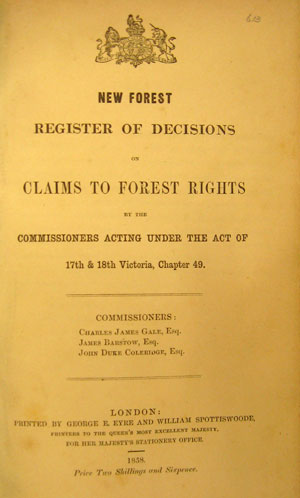 published in 1858 is the handbook of who is entitled to what on the New Forest. In many commoning families it is regarded as the 'bible' of the Forest. Following inquries into the management of all the Royal Forests a decade earlier it was decided that updating the register of claims would be an important part of valuing the New Forest. The 1848 inquiry concluded that a separation of commoners rights from crown rights would be of advantage to the crown. The deer would be removed and more land could be set aside for timber plantations.
published in 1858 is the handbook of who is entitled to what on the New Forest. In many commoning families it is regarded as the 'bible' of the Forest. Following inquries into the management of all the Royal Forests a decade earlier it was decided that updating the register of claims would be an important part of valuing the New Forest. The 1848 inquiry concluded that a separation of commoners rights from crown rights would be of advantage to the crown. The deer would be removed and more land could be set aside for timber plantations.
The book was one of the famous government 'blue books' printed by Eyre and Spottiswood for Her Majesty's Stationery Office. The Eyre was George Eyre a member of the family still resident in Bramshaw who have been active for many generations in Forest affairs. One thousand three hundred and eleven claims are listed in the book, all are shown as either amended or disallowed. Apart from the claim number they give name, address and occupation of the claimant, the date the decision was made, the nature of the claim as amended and the size and location of the lands to which they refer.
The claims are for common of pasture, turbary, mast, fuel wood, sheep and marl. The first is the most important today allowing the successful claimant to depasture ponies, donkeys or cattle on the Forest.
| Right | Allowed |
| Pasture | Ponies, Donkeys, Cattle |
| Turbary | Cutting turf for burning |
| Mast | Pigs to eat acorns in the autumn |
| Fuel wood | Wood for burning |
| Sheep | Sheep pasture, rare |
| Marl | Clay like fertilizer |
The claim here by Joseph Short, Lyndhurst's grocer, for tithe areas 209 and 177 cover the land now occupied by the car park and New Forest Centre. It looks as if the Centre could run ponies and pigs on the Forest for the right goes with occupancy of land and not the individual. This is also a reminder that for most people commoning was part of their way of life but not the only means by which they earned a living.
This book provides the basis for modern day claims although for ease of use the tithe numbers in the claims book have been transferred to an Atlas, a copy of which is held by the Verderers Clerk in Lyndhurst
 Sumner's Guide to the New Forest
Sumner's Guide to the New Forest
was published in 1923 by Charles Brown and son of Ringwood. The guide, although produced more than 80 years ago, is in many ways the best guide to the woods of the New Forest. Sumner shows their character by loving description as well as his very attractive drawings and map. Two editions appeared; without advertisements for 2s 6d (12½p) and with for 1s 6d (7½p)
Sumner, in his preface, said:
This little guide-book is planned for the wayfarer - to suit his pocket both in size and cost. It is written by one who has known and loved the Forest for forty years. It claims to be a handy companion, giving a brief account of the District, past and present, of its topography, history, traditions and scenery; and it aims at supplying a useful introduction to the subject, reminiscent of the past, and of the varied beauty that pervades this wild expanse of wood and heathland….
It is difficult to add to that. He deliberately ignored the church architecture as being described elsewhere but included such delightful descriptions of the real Forest that the book was reprinted not only in his lifetime but also fifty years later. Following the descriptions of the Forest area by area he included chapters on ‘Natural Landmarks’, ‘Forest Terms’ and ‘Forest Notes’. This allowed his readers, then and now, the opportunity to become familiar with Forest terms such as Agister, Assart, Vert, Estover and Turbary. He listed the rights of common and of fuel and even gave brief notes on population in the villages as well as rainfall figures. Lymington had an average of 33 inches for the years 1910-1919 as against nearly 36 inches at Cuckoo Hill where he lived at Gorley and 39 inches at Lyndhurst.
In the areas he works through the place names alphabetically making this a most useful reference book as well as a pleasure to read. Under ‘Picked Post’ he states ‘This place is now usually spelt “Picket,” but “picked” was the spelling in the Ordnance Map of 1817, and in all maps previous to that date…Picked is a Wessex word in present use, meaning pointed…. The name probably referred to the pointed angle of the roads that join here.’
John Wise's The New Forest Its History and Scenery 
was first published in 1863. It ran to five editions with a number of variations in the 19th century together with a reprint in the 20th. It remains a standard work because he captured an understanding of the area by his own observations and enquiries together with enlisting help from many local specialists.
During the previous year he had toured the Forest with the young Walter Crane who provided 63 illustrations; neither were New Forest men. Something of a literary Gypsy, Wise was born to a well-to-do Devon family but lost his parents early. He was educated at Grantham School and Oxford University but left without a degree to further his passion for travel, ornithology and writing. He became deeply interested in many aspects of the natural world and developed a love for words. He contributed to the Westminster Review and Cornhill magazines before publishing a slim volume of poems entitled Robin Hood.
In The New Forest he provided an overview of the history and archaeology together with a guide to the villages and 'wild' places within the New Forest. His knowledge and evident love of the area for its own sake helped bring about a better understanding of how everybody could benefit from it.
"But in its wild scenery lies its greatest charm. From every hill-top gleam the blue waters of the English Channel... Nowhere, in extent at least, spread such stretches of heath and moor, golden in the spring with the blaze of ferns, and in the autumn purple with heather, and bronzed with the fading fern. Nowhere in England rise such oak-woods, their boughs rimed with the frostwork of lichens, and dark beech-groves with their floor of red brown leaves, on which the branches weave their own creative warp and woof of light and shade."
In 1881 Wise came into some money by the death of his uncle Henry Ellison. It is probably not a co-incidence that a fourth edition of his by now famous work appeared. The Artist's Edition, which incorporated the original 63 Crane illustrations, was further enhanced with 12 etchings by artist and archaeologist Heywood Sumner. The books were finely bound in birch and produced in a numbered, limited edition of 350. A further 50 were also produced in a slightly larger format and again bound in birch; both were published in 1883.
Further travels included living in Yorkshire and Edwinstow on the edge of Sherwood Forest before he returned to the New Forest in the autumn of 1889. He suffered illness at his boarding house, South View in Gosport Road, Lyndhurst and died there on 1st April 1890. He is buried close to the gate of the cemetery beyond Bolton's Bench in the New Forest he came to love.
In the preface to the Artist's Edition of August, 1882 he concluded:
"We may indeed rejoice that Epping Forest has lately been bought as a park for the people of London, but we should rejoice still more that the New Forest requires not to be purchased... but that it remains, not indeed now the hunting-ground of a king, but the park of the nation."

